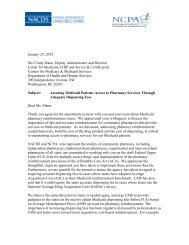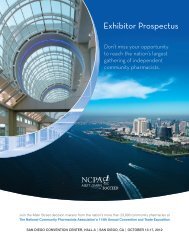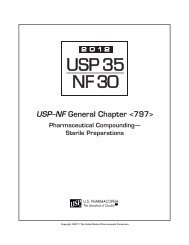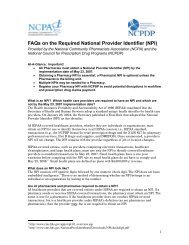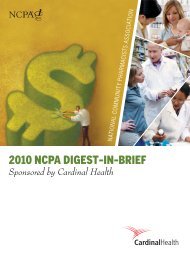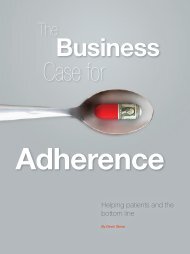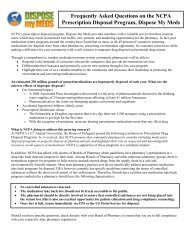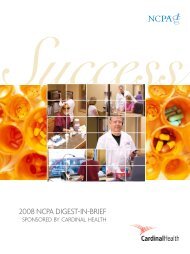NATIONAL COMMUNITY PHARMACISTS ASSOCIATION
NATIONAL COMMUNITY PHARMACISTS ASSOCIATION
NATIONAL COMMUNITY PHARMACISTS ASSOCIATION
- No tags were found...
Create successful ePaper yourself
Turn your PDF publications into a flip-book with our unique Google optimized e-Paper software.
Rural/Metro Pharmacy LocationPharmacies defined their market type based upon thepopulation of their region. The categories were:n Population less than 20,000n Population from 20,000 to 50,000n Population more than 50,000Over 50 percent of independent community pharmaciesare located in an area with a population of less than 20,000.Financial statements comparing pharmacies in these categoriesare provided in Tables 18, 19, and 20.The common-sized income statement shows that thepharmacies in areas with less than 50,000 people had lowergross margins than pharmacies in areas with a populationgreater than 50,000. These same pharmacies in areas witha population of less than 50,000 also experienced higherpayroll expenses as a percentage of sales. This may be dueto the pharmacist shortage, and pharmacies having topay more to attract a pharmacist to rural areas. Becausepharmacies in areas with population greater than 50,000had higher gross margins and maintained their expenses,they had a greater average net operating income percentageat 3.9 percent.Median sales for pharmacies with populations over 50,000were higher in the pharmacies in areas over 50,000 at$3,975,570. Yet with the median net operating incomepercentage, these pharmacies were able to earn $80,210 inmedian net operating income dollars before tax. Pharmaciesin rural areas of less than 20,000 had median sales of$3,101,707 and earned $94,861 in median net operatingincome dollars before tax.TABLE 18 • 2008 Common-Sized (Average)Income Statement, Percentage of Total Sales—Metropolitan vs. RuralPopulationlessthan 20,000Population of20,000 to50,000Populationmorethan 50,000SalesPrescription sales 92.8% 93.4% 93.4%All other sales 7.2% 6.6% 6.6%Total Sales 100% 100% 100%Cost of Goods SoldPrescriptions costs 71.7% 70.7% 71.7%All other costs 4.6% 5.8% 4.1%Total Cost of Goods Sold 76.3% 76.5% 75.8%Gross Profit 23.7% 23.5% 24.2%Operating ExpensesPayroll expensesSalaries, wages 11.8% 12.3% 11.7%Payroll taxes, workers’comp, employee benefits1.8% 1.9% 1.7%Payroll Expenses 13.6% 14.2% 13.4%Other Operating ExpensesAdvertising 0.5% 0.5% 0.4%Insurance 0.4% 0.4% 0.4%Store supplies, containers,labels0.5% 0.4% 0.4%Office postage 0.1% 0.1% 0.1%Delivery service 0.2% 0.2% 0.5%Pharmacy computerexpense0.4% 0.4% 0.5%Rent 1.2% 1.3% 1.2%Utilities, telephone 0.4% 0.4% 0.4%All other operating3.1% 2.7% 3%expensesTotal Other OperatingExpenses6.8% 6.4% 6.9%Total Expenses 20.4% 20.6% 20.3%Net Operating Income 3.3% 2.9% 3.9%382009 NCPA Digest, sponsored by Cardinal Health



